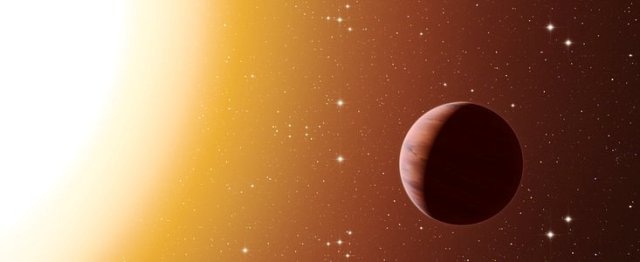Jun 20 2016
A team of astronomers from all over the world have discovered that there are many more planets similar to the hot Jupiter type than expected in a cluster of stars known as Messier 67. The HARPS spectrograph at ESO’s La Silla Observatory in Chile is one among the various instruments and telescopes that were used to make this unexpected discovery. The increasing number of hot Jupiters is the result of the recurrent interactions between planets and nearby stars that is caused due to the denser environment present in a cluster.
 This artist's impression shows a hot Jupiter planet orbiting close to one of the stars in the rich old star cluster Messier 67, in the constellation of Cancer (The Crab). Astronomers have found far more planets like this in the cluster than expected. This surprise result was obtained using a number of telescopes and instruments, among them the HARPS spectrograph at ESO's La Silla Observatory in Chile. The denser environment in a cluster will cause more frequent interactions between planets and nearby stars, which may explain the excess of hot Jupiters. CREDIT: ESO/L. Calçada
This artist's impression shows a hot Jupiter planet orbiting close to one of the stars in the rich old star cluster Messier 67, in the constellation of Cancer (The Crab). Astronomers have found far more planets like this in the cluster than expected. This surprise result was obtained using a number of telescopes and instruments, among them the HARPS spectrograph at ESO's La Silla Observatory in Chile. The denser environment in a cluster will cause more frequent interactions between planets and nearby stars, which may explain the excess of hot Jupiters. CREDIT: ESO/L. Calçada
A European, Brazilian, and Chilean team headed by Roberto Saglia at the Max-Planck-Institut für extraterrestrische Physik, in Garching, Germany, and Luca Pasquini at ESO, spent a number of years gathering high-precision measurements of 88 stars in Messier 67. This cluster of open stars is the same age as that of the Sun, and it is believed that the Solar System developed in a similarly dense environment.
The astronomers used HARPS together with other instruments in order to identify the signatures of giant planets on short-period orbits, with the hope to come across the tell-tale “wobble” of a star created by the existence of an extremely big object in a close orbit, which is a specific type of planet referred to as a hot Jupiters. Currently, this hot Jupiter signature has been found for three clusters together with previous evidence for various other planets.
A hot Jupiter is known as a giant exoplanet containing a mass that is more than almost a third of Jupiter’s mass. These planets are hot as they orbit near their parent stars, as highlighted by an orbital period (their “year”) that is considered to be less than ten days in duration. This indeed is different from the commonly known Jupiter present in the Solar System, which is a lot colder than the Earth and has a year lasting around 12 Earth- years.
We want to use an open star cluster as laboratory to explore the properties of exoplanets and theories of planet formation. Here we have not only many stars possibly hosting planets, but also a dense environment, in which they must have formed.
Roberto Saglia, Max-Planck-Institut für extraterrestrische Physik
The study discovered that several hot Jupiters exist around stars in Messier 67 when compared to those stars present outside clusters. “This is really a striking result,” marvels Anna Brucalassi, who carried out the analysis. “The new results mean that there are hot Jupiters around some 5% of the Messier 67 stars studied — far more than in comparable studies of stars not in clusters, where the rate is more like 1%.”
Astronomers assume that it is majorly unlikely that these giant stars actually develop where they are currently found, as the surrounding environment of the parent star would not primarily have been ideal for the creation of Jupiter-like planets. Instead, it is believed that these stars are developed further out, very similar to Jupiter, and then shifted nearer to the parent star. Planets that were previously regarded as giant and cold are currently a great deal hotter. The question at this point focuses on what caused them to move inwards towards the star.
A number of answers exist for this query, but the authors finally highlight that this is indeed the result of close encounters with nearby stars, or even with the planets existence in the nearby solar systems. Another answer is the fact that the immediate environment surrounding a solar system can create a major impact on how it evolves.
In Messier 67, and other similar clusters, where stars are found to be a lot closer than the average, such experiences will turn out to be a lot more common, which indeed will provide an explanation for the increasing numbers of hot Jupiters.
Co-author and co-lead Luca Pasquini from ESO looks back on the remarkable recent history of studying planets in clusters: “No hot Jupiters at all had been detected in open clusters until a few years ago. In three years the paradigm has shifted from a total absence of such planets — to an excess!”